Almost six months to the day after beginning, I finished the embroidery for my green silk bliaut. And it feels
marvelous. It also feels like I should have finished this ages ago—the vining only took about 10 hours of work once I stopped fidgeting and did it. At least I got a bit of weaving done while I was avoiding embroidery.
 |
| I shouldn't have snickered in geometry when they said we'd use those skills again later. |
I have a pattern cut out and marked, but realized it would be easier to construct the outlines again than to trace off a wriggly piece of old sheet. So I packed a plate with the right diameter, and used a spare magazine at work to keep my lines and corners square as I marked everything. The inner circumference may not be absolutely circular—I marked a number of points at the right distance from the outer rim, and connected the dots—but it's close enough for government work (Grandpa taught me that before I understood the joke).
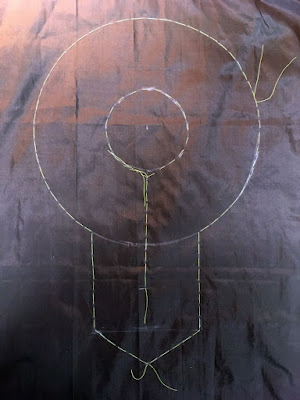 |
| I think I love basting outlines. |
Because I am familiar by now with the vagaries of chalked designs on smooth-surfaced silk, I basted the outlines of everything important before starting on the embroidery.
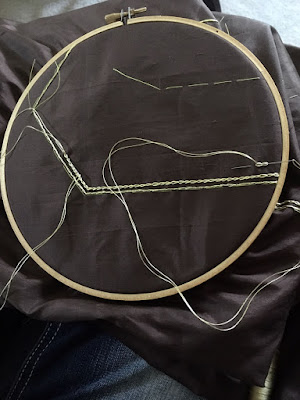 |
| Mostly straight lines. |
I proceeded to rub away all the chalk as I added a split stitch outer border, followed by the two chain stitch borders like the rest of the trim, and a final inner split stitch border. Had I been thinking when I put the first line of stitching in, I would have used two needles from the beginning. Instead I finished one line, then picked up the second needle, so I had to move the hoop around the piece a bit more than I'd've liked.
 |
| Same brown silk as before, except...purple. Because it felt like it. |
Still deciding whether to do an inner border here. Luckily there's plenty of work to do while I contemplate the idea.
 |
| Note to self: mark out all the lines if you're gonna take artsy macro shots. Sheesh. |
These narrow borders are just more than half the width of the narrow borders on the other trim, so I adjusted the spacing of the crosses accordingly. In case you're wondering, marking quarter-inch spacing in a tiny channel on silk is not the funnest thing I've ever done.
I also fiddled with the spacing at the corners, hoping for a clean way to turn the pattern, and I think this solution—adding an intersection directly on the corner—worked very well. It creates kite-shaped voids at the corners, rather than the (fairly) regular lozenges on the straight portions.
 |
| Probably never getting over how dramatically that fill stitch alters the look of the piece. |
I used two needles for the crosses, working one before the other all the way around. It's nearly impossible to tell which arm of the cross was stitched first once they're tacked down, but the regularity makes me happy.
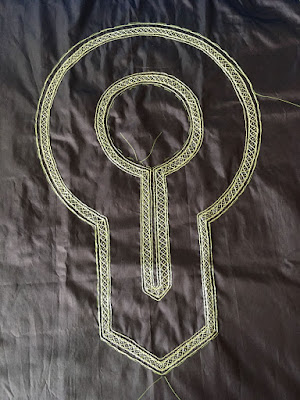 |
| So. Many. French. Knots. |
The inner border seemed like a good idea, both to help stabilize that edge and to better match the other pieces of trim. I removed the center basting line after the first split stitch border—there should be
just enough fabric for me to stitch a very tiny seam and cut open the neck slit. If I'm wrong, I run the risk of having the whole collar slowly unravel. Hopefully I'm not wrong.
As with the other trim, I tacked down the centers of the crosses and added French knots in the open spaces of the diamonds; a blisteringly slow process, with the tiny spacing of the diamonds. (For some sense of scale, the diameter of the center circle is only 3.5 inches.)
 |
| Oh, like you don't mutter to yourself about spacing while chalking possible vine arrangements at the laundromat. Please. |
I still hadn't made any real decisions about the final form of the vine pattern when I finished the narrow borders, so I started by marking the corners I'd need to navigate. I also wanted the design to flow symmetrically from the center back to the center front. From there, I started marking rough two-inch divisions along the outer circle, dividing the center back section in half once I'd worked from both front corners to the middle.
The straight sections of the neck slit posed a challenge, being much narrower than the main body of the collar. I went with 1.5-inch divisions there, measuring from the outer border's upper corner toward the point.
With the divisions marked, I sketched out a vining pattern clearly related to the main trim, and started the base chain stitch from the center back, to keep the vines flowing properly for symmetrical minor vines and leaves later.
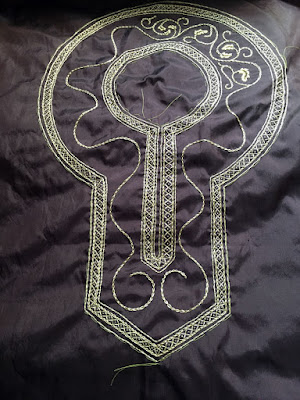 |
| Yes, I am allergic to doing the exact same thing more than once. |
I'd originally planned to do three-leaf spirals on all the minor vines in the collar, probably with a mix of filled, half-filled, and outlined leaves, but I quickly realized there wouldn't be space for graceful three-leaf spirals in all (or even most) of the undulations I'd laid out. So I went with a variety of leaf spirals, and all filled leaves, using four strands of silk for the fill and two strands for the vines. I like the subtle texture that added, and it also meant I always had both super-sharp needles attached to thread and less likely to end up in my foot after falling out of my bag.
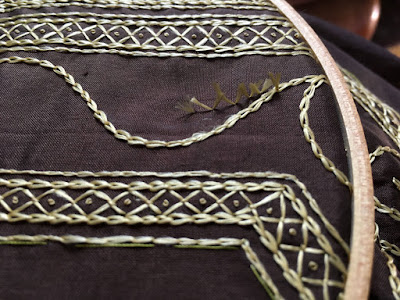 |
| Almost cute enough to leave as a design feature. |
When I reached the narrow portion of the neck slit, I included one vine-only loop, but the first direction I tried to lay out the vine just didn't work. Chain stitch is not a polite, easy-to-remove stitch. You have to either work back very delicately, one stitch at a time, including the itty-bitty anchor stitches that hold the chains open, or snip each loop and pull the shreds of thread free. I opted for snipping. It's much faster, and I was fairly confident my wound thread would last through the rest of the collar, so I didn't mind wasting a little bit.
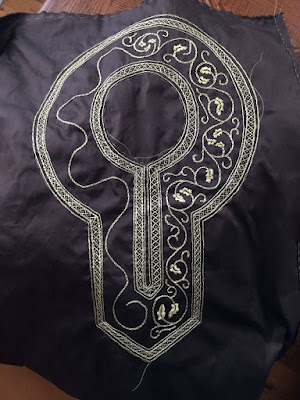 |
| There is a massive stack of books under there. |
At the halfway point I took a break to run some books to the library, and then it was right back to stitching (after a detour to avoid a street fair blocking the easy route home).
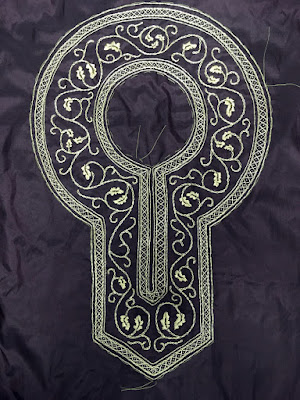 |
| inarticulate squealy noises |
VOILA. C'est fini. As always, there are bits I'd go back and change, but I'm really very pleased with this piece. And I...don't have anything left to embroider for this dress. At least not right now—I'd like to take a look at the remaining peach fabric, to see if there's enough for an embroidered sash, but that'll be a project for
another day. Right now, I have a dress to construct.












Comments
Post a Comment